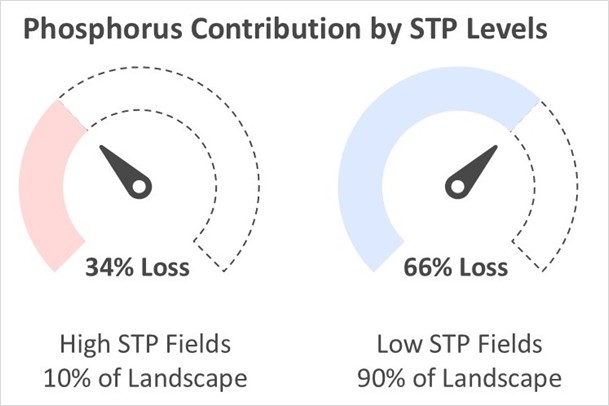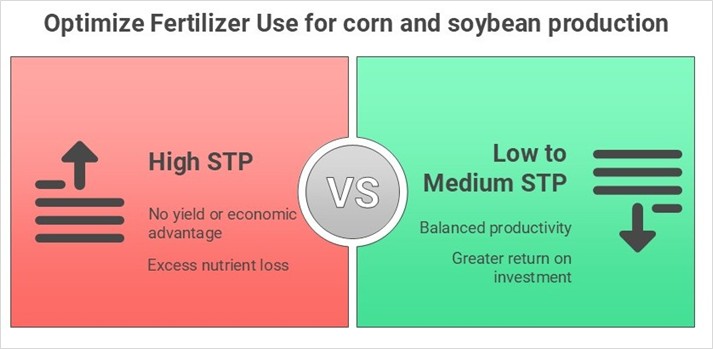No payoff from high soil test phosphorus: Save fertilizer and protect water quality
Applying phosphorus when the soil test phosphorus is high doesn’t boost profit. Stick to the tri-state guidelines to protect your bottom line and water quality.

Important takeaways
- High soil test phosphorus (STP) fields lose more phosphorus per acre, even though they make up a small share of the landscape.
- Most phosphorus loss still comes from fields with soil test phosphorus below 75 mg/kg, so conservation practices are important across all fields, not just the high-testing ones.
- Adding phosphorus to high or very high soil test phosphorus soils doesn’t increase yield. There’s no agronomic or economic benefit for corn and soybean production.
- Fertilizing when soil test phosphorus is in the low to medium range gives the best return on investment.
- Lowering high soil test phosphorus through crop removal takes time. It can take up to 16 years to cut soil test phosphorus in half in high-testing soils.
- Stick to the tri-state fertility guidelines to maintain crop productivity while reducing phosphorus loss to water.
Lake Erie continues to experience summer algal blooms due to excess phosphorus. While phosphorus enters the lake from various sources, agriculture remains the dominant contributor. Recent research highlights the significant role of legacy phosphorus—phosphorus that has accumulated in soils over time—in fueling these blooms. If your soil already tests high in phosphorus, adding more won’t improve yields, but it can harm your bottom line and local water quality.
Why is high soil test phosphorus a problem?
New research confirms that high soil test phosphorus levels are a disproportionate source of phosphorus loss to surface water (Figure 1). In a study by Byers et al. in 2025 of 41 fields in the Western Lake Erie Basin, fields with soil test phosphorus levels above 75 parts per million contributed up to 34% of dissolved reactive phosphorus loads, even though they represented only 10% of the landscape. These elevated-soil test phosphorus fields are not the dominant source of phosphorus loss, but they do contribute more per acre than fields with lower soil test phosphorus. Drawdown of soil test phosphorus levels is a slow but necessary strategy to mitigate high phosphorus concentrations and address legacy phosphorus losses to surface water.

What is soil test phosphorus drawdown?
Soil test phosphorus drawdown refers to the gradual reduction of phosphorus levels in soil through crop uptake without additional phosphorus fertilizer applications. While this is a key strategy for reducing phosphorus loss to water bodies, it’s a slow process. A recent study by Gatiboni et al. in 2025 found that it can take up to 16 years to reduce soil test phosphorus by half in high-testing soils.
No yield or profit gain from high soil test phosphorus levels
A separate study by Kaiser et al. in 2025 confirms that maintaining high to very high soil test phosphorus levels offers no yield or economic advantage for corn and soybean production (Figure 2). In fact, a greater return on investment comes from fertilizing when soil test phosphorus is in the low to medium range. Maintaining soil test phosphorus at or slightly above the critical level ensures productivity without the excess risk of nutrient loss.

Recommendation: Keep soil test phosphorus within tri-state guidelines
The Tri-State Fertilizer Recommendations provide target soil test phosphorus ranges that balance agronomic productivity with environmental stewardship. Fields with high soil test phosphorus should prioritize drawdown through crop removal and avoid unnecessary phosphorus applications. For fields with low or medium soil test phosphorus, applying phosphorus based on crop needs is sufficient to maintain yields without increasing environmental risk.
Bottom line
Stick to the Tri-State Fertilizer Recommendations; apply phosphorus only where it’s needed and let crops gradually draw down excess phosphorus. This long-term strategy protects both your profits and our water. In the short term, stack nutrient and water management practices to reduce phosphorus loss more effectively.



 Print
Print Email
Email



